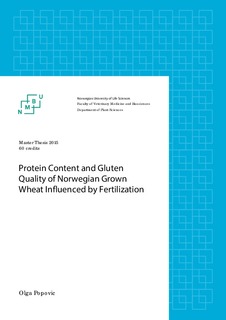| dc.description.abstract | Protein content and protein quality are important factors for bread making performance of the flour. The protein content widely varies between the types and classes of wheat, in amounts from 8-20%. It is strongly dependent on growing conditions, soil fertility and temperature during the season, fertilizer inputs, and nitrogen in particular. Higher protein content can be achieved by giving higher N fertilization and particularly by using split application methods. The protein quality tends to vary according to variations of the gluten proteins. Because there are large numbers of different combinations of storage protein components, their evaluation is complex and hard. Baking and different chemical tests, as well as the rheological tests on flour, dough and gluten are often regarded as good parameters to determine wheat quality.
During recent years the Norwegian food wheat production has been decreasing, especially since 2008. This is caused mainly by decrease in production area as well as by high precipitation during maturation and harvest in autumn, giving pre-harvest sprouting with extremely difficult harvest in 2011. However, autumn for the season 2013/14 was dry, showing slight increase in use of Norwegian wheat for flour and a specially good season followed in 2014, giving good gluten quality and spring wheat with high protein content compared to the later seasons. A high proportion of Norwegian wheat of about 70% was again used in 2014/2015 seasons. This study investigated the effect of fertilizers on the main quality traits, protein content and gluten quality and suggested possible strategies for management in agricultural practice on how to reach higher productivity.
Three experiments examined effects of nutrient availability on quality parameters with special focus on viscoelastic properties of gluten. The results from material showed strong effects of N fertilization regimes, giving variations in both, protein content and viscoelastic properties. The results showed increased Ext and decreased Rmax, which combine the same trend in accordance with earlier seasons in Norway. In the results where the effect of P and K fertilization on gluten viscoelastic properties was studied, the same effect was found. Ext increased and Rmax decreased with increased P level. Also, interesting trend of increased Rmax at the higher K level was found. Considering, there are significant interactions between P and K levels on viscoelastic properties of gluten, it is of interest to explore how some other factors influence the variability in protein content and not only nitrogen fertilization. | nb_NO |
